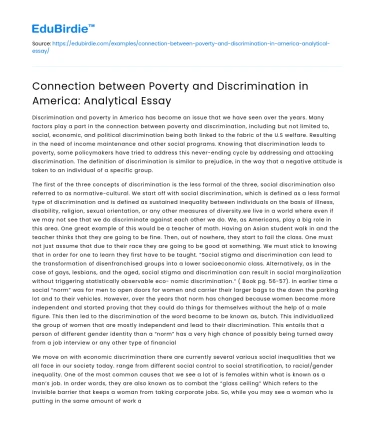Introduction
Poverty and discrimination are intricately linked phenomena that continue to pose significant challenges in the social fabric of America. On the surface, poverty appears as a mere economic disadvantage; however, its roots often intertwine with various forms of discrimination, such as racial, gender, and age-based biases. According to the U.S. Census Bureau, around 11.4% of the population was living in poverty as of 2020, a statistic that disproportionately affects minority groups and women. These disparities are not coincidental but are indicative of systemic inequities that perpetuate a cycle of poverty and discrimination. This essay seeks to unravel the complexities of this relationship by examining the underlying causes, the role of systemic inequality, and the implications for societal progress. In doing so, it will highlight real-life cases and scholarly perspectives that underscore the need for comprehensive policy reforms to address these intertwined issues.
Historical Context and Systemic Inequality
The historical context of discrimination in America is essential to understanding its connection to poverty. The legacy of slavery, segregation, and institutionalized racism has created a foundation for persistent economic disparities. According to a report by the Economic Policy Institute, African Americans are more than twice as likely to live in poverty compared to their white counterparts, a disparity rooted in centuries of discriminatory practices. The Jim Crow laws and redlining policies of the 20th century, for instance, systematically denied African Americans access to quality education, employment, and housing. These practices have had long-lasting effects, resulting in wealth gaps that persist to this day. Moreover, Native American communities face similar challenges due to historical injustices, including land dispossession and cultural erasure, which have severely limited their economic opportunities.
Save your time!
We can take care of your essay
- Proper editing and formatting
- Free revision, title page, and bibliography
- Flexible prices and money-back guarantee
These systemic inequalities are not only historical but are perpetuated through modern-day policies and practices. For example, the criminal justice system disproportionately targets minority communities, leading to higher incarceration rates that disrupt family structures and economic stability. Michelle Alexander, in her seminal work "The New Jim Crow," argues that mass incarceration functions as a contemporary system of racial control, further entrenching poverty within African American communities. This systemic inequality creates a vicious cycle where discrimination begets poverty, and poverty, in turn, exacerbates vulnerability to discrimination.
The Impact of Discrimination on Economic Opportunities
Discrimination in the workforce is a significant factor contributing to the economic hardships faced by marginalized communities. Despite legal frameworks such as the Civil Rights Act of 1964, which aimed to eliminate workplace discrimination, biases persist in hiring practices, wage disparities, and career advancement opportunities. A study by the National Bureau of Economic Research found that resumes with names perceived as African American received significantly fewer callbacks than those with Caucasian-sounding names, illustrating the subtle yet pervasive nature of racial bias in employment.
Gender discrimination further compounds these challenges, particularly for women of color who face the dual burden of racial and gender biases. The gender pay gap is more pronounced among minority women, with African American and Hispanic women earning significantly less than their white male counterparts. This economic disparity limits their ability to accumulate wealth, invest in education, and access quality healthcare, perpetuating a cycle of poverty. It is crucial to recognize that these discriminatory practices are not isolated incidents but are indicative of broader structural inequities that hinder economic mobility for marginalized groups.
Counter-Arguments and Policy Implications
While some argue that individual effort and meritocracy can overcome poverty and discrimination, this perspective fails to account for the systemic barriers that disproportionately affect marginalized communities. Critics of policy interventions often cite the potential for dependency on welfare programs; however, research indicates that targeted support can break the cycle of poverty. Programs that focus on education, job training, and affordable housing have shown promise in reducing economic disparities.
To address the root causes of poverty and discrimination, comprehensive policy reforms are necessary. These should include measures to promote equitable access to education, healthcare, and employment opportunities. The implementation of affirmative action policies, for instance, can help level the playing field by ensuring that marginalized communities have fair representation in educational institutions and workplaces. Furthermore, criminal justice reform aimed at reducing incarceration rates for non-violent offenses can alleviate the economic burden on minority communities and promote social reintegration.
Conclusion
In conclusion, the connection between poverty and discrimination in America is a multifaceted issue that requires a nuanced understanding of historical and contemporary factors. The legacy of systemic inequality continues to manifest in economic disparities that disproportionately affect marginalized communities. Addressing these issues necessitates a collaborative effort among policymakers, educators, and community leaders to implement reforms that promote equity and inclusion. By dismantling discriminatory practices and providing equitable opportunities for all, America can move towards a more just and prosperous society. The journey towards achieving this goal is complex, yet it is imperative for the nation's social and economic well-being.






 Stuck on your essay?
Stuck on your essay?

